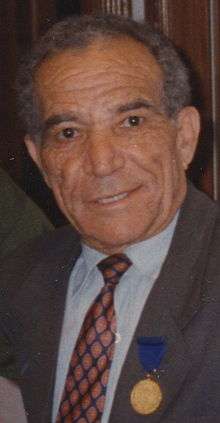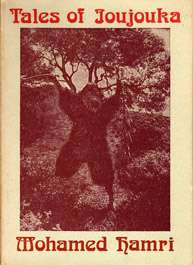Mohamed Hamri
| Mohamed Hamri | |
|---|---|
 Mohamed Hamri | |
| Background information | |
| Also known as | Hamri |
| Born |
August 27, 1932 Ksar el-Kebir, Morocco |
| Origin |
|
| Died | August 29, 2000 (aged 68) |
| Genres | Sufi music |
| Occupation(s) | Painter |
Mohamed Hamri (August 27, 1932 – August 29, 2000), commonly known as Hamri, was a self-described Painter of Morocco.[1] He was a Moroccan painter and author and one of the few Moroccans to participate in the Tangier Beat scene.[2]
He was born in 1932 in Ksar-el-Kebir in northern Morocco. His father was a ceramics artist who painted his pieces following an ancient tradition. Hamri's mother was born into the Attar family of Zahjouka musicians. His uncle was the leader of the Master Musicians of Joujouka.[3]
Hamri is father to Sanaa Hamri, the first Moroccan woman to direct a Hollywood movie.
Career
Hamri helped the Master Musicians of Joujouka survive by bringing them to Tangier to play. In 1951, writer Paul Bowles met the 18-year-old Hamri at Tanger train station. He later met the painter Brion Gysin—inventor of The Cut-up technique—who tutored him and introduced him to modern European painters. Gysin and Hamri had a joint exhibition in 1952. After Hamri introduced Gysin to the Zahjouka village, Gysin became a lifelong promoter of the Sufi trance master musicians who lived there. Together with Gysin, Hamri set up the "1001 Nights Restaurant" in Tangier with Hamri as cook and where Gysin employed the Master Musicians to play.[4] In 1958 Gysin bought out Hamri's interest in the restaurant for $10,000 but he soon lost the restaurant himself.[5] He soon opened a new 1001 Nights in Asilah—40 km south of Tangier—where he first met Brian Jones and subsequently brought him to Zahjouka.[6]
Meeting with Brian Jones
Rolling Stones lead guitarist Brian Jones met Hamri when he visited Morocco in 1967. They then developed a close friendship.[6] In 1968, Gysin and Hamri took Jones to the village to record the master musicians in the ground-breaking release Brian Jones Presents The Pipes of Pan at Joujouka, whose original cover featured a painting of Jones and The Master Musicians of Joujouka by Hamri before a 1990s redesign.[7]
In 1975, Hamri's book Tales of Joujouka, which told stories from the village, including "The Legend of Boujeloud", the half-goat/half-man creature celebrated in the annual ritual, was published by Capra Press in Santa Barbara.[8]

From 1980 onwards, Hamri divided his time between Tangier and Zahjouka. After the death of Hadj Abdesalam Attar his son Bachir Attar continued his father's group's music with The Master Musicians of Jajouka led by Bachir Attar. In a break from Morocco between 1974 and 1978 to pursue his painting career, Hamri published his Tales of Joujouka.
1990s to 2000
On his return to Morocco Hamri built a new house in Zahjouka, which became a gathering place for the musicians. Using his reputation as an artist, he invited them to shows when only he had been invited to exhibit as a painter. In 1991 he brought the group to Italy. In 1992, Hamri participated in The Here to Go Show in Dublin, Ireland. The show, a celebration of William Burroughs, Brion Gysin and the Tangier beat scene, was documented in the documentary Destroy all Rational Thought, directed by Joe Ambrose and Frank Rynne. In 1994 Hamri arranged for the Master Musicians of Joujouka to record their first CD release Joujouka Black Eyes. The recording was produced by Frank Rynne under Hamri's supervision.[9]
Hamri had over 50 exhibitions of his paintings in Morocco, Spain, Lebanon, Canary Islands, Germany, United States, UK and Ireland during his lifetime.[10]
He died in 2000 and is buried in the centre of the village, close to the tomb of the local Muslim saint Sidi Ahmed Sheikh. A recent retrospective was held at the Laurence-Arnott Gallery in Tangier. A large collection of his 1950s paintings has recently been discovered in the United States.
Books
| Moroccan literature |
|---|
| Moroccan writers |
|
| Forms |
|
| Criticism and awards |
|
| See also |
|
- Hamri is characterised as "Hamid" in Brion Gysin's novel The Process
- Tales of Joujouka is Hamri's stories from his Sufi village in Morocco.
- Man from Nowhere Storming the citadels of enlightenment with William Burroughs and Brion Gysin, by Ambrose, Rynne, Wison, features both information on and an article by Hamri.
- Clandermond, Andrew, MacCarthy Terence, Hamri the painter of Morocco , (Tangier,2004) Biography and reproductions of Hamri art
See also
References
- ↑ Le Matin du Sahara et du Maghreb,(Tangier, Morocco February 15, 2002)
- ↑ Obituary of Hamri from The Independent (London, October 19, 2000)
- ↑ Clandermond, Andrew, MacCarthy Terence, Hamri the painter of Morocco , (Tangier,2004)pp 1–3,
- ↑ Greene, Michelle, "The Dream at the End of the World", (New York, 1991), p.123, p.201
- ↑ Greene, Michelle, The Dream at the End of the World, (New York, 1991), p.201
- 1 2 Clandermond, Andrew, MacCarthy Terence, Hamri the painter of Morocco , (Tangier,2004), p.9
- ↑ Sleeve Note Brian Jones presents the Pipes of Pan at Jououka, Rolling Stones Records, 1971
- ↑ Hamri, Mohamed, Tales of Joujouka, (Santa Barbara, 1975)
- ↑ Campion, Chris, "Night Spirit Masters" The Wire, August 1995
- ↑ Clandermond, Andrew, MacCarthy Terence, Hamri the painter of Morocco , (Tangier,2004), pp 39–42.
Further reading
- Ambrose, Joe; Wilson, Terry; and Rynne, Frank (1992). Man from Nowhere: Storming the Citadels of Enlightenment With William Burroughs and Brion Gysin. Autonomedia. ISBN 0-9520217-0-6.
- Hamri, Mohamed (1975), Tales of Joujouka. Capra Press.
- Palmer, Robert (March 23, 1989). "Into the Mystic". Rolling Stone.
- Palmer, Robert (October 14, 1971). "Jajouka: Up the Mountain". Rolling Stone, p. 39–40.
- Palmer, Robert (June 11, 1992). "Up the Mountain". Rolling Stone, p. 42–43.
- Ranaldo, Lee (August 1996). "Into The Mystic". The Wire
- Strauss, Neil (October 12, 1995). "The Pop Life: To Save Jajouka, How About a Mercedes in the Village?". The New York Times.
External links
- Feature article "A Rolling Stone's Moroccan Odyssey" Frank Rynne writes on Hamri, Brian Jones, Brion Gysin and The Master Musicians of Joujouka, Irish Times, 22 July 2008
- Obituary of Hamri from The Independent (London, 19 Oct 2000) pdf download of original article at bottom of text.
- Master Musicians of Joujouka site
- Guardian article on Tangier and interview with Hamri's widow Blanca Hamri on meeting her husband 22 April 2008